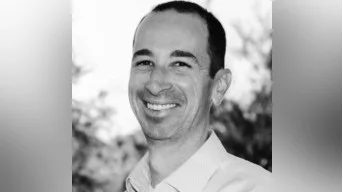Ohio clean energy projects under an Inflation Reduction Act grant announced last month demonstrate how solar installations on closed landfills can reduce greenhouse gases, improve resilience, and provide funding for other environmental goals.
Part of the $129.4 million grant from the U.S. Environmental Protection Agency will add 28 megawatts of solar generation to a county central services facility and four former landfill sites in Cleveland and Cuyahoga County. A larger portion of the funding will bring 35 MW of solar and 10 MW of battery storage to a brownfield site in Painesville in Lake County, enabling the city to close a coal-fired peaker plant that dates back to 1908.
Representatives from Cleveland, Painesville, Cuyahoga County governments, along with the EPA and others, met on July 26 at Cuyahoga County’s 4 MW solar array in Brooklyn, Ohio, to discuss the grant and its implications. Funding from the EPA grant will more than double the generation capacity of that landfill solar site, which has been operational since 2018.
“In Northeast Ohio we’re going to see warmer, wetter, wilder weather in this region. And we have to do our part to address climate change,” said Mike Foley, director of sustainability for Cuyahoga County.
Projects funded by the grant are expected to eliminate the equivalent of one million metric tons of carbon dioxide over a 25-year period. The largest reductions are anticipated from deploying solar projects in Cuyahoga County, Cleveland, and Painesville according to Valerie Katz, deputy director of sustainability for Cuyahoga County.
The largest share of grant money will go to Painesville in Lake County east of Cleveland. However, the 28 MW of solar generation planned for Cuyahoga County is also expected to have significant impact.
“This will triple our solar capacity in Cuyahoga County in the next five years,” Katz said.
The landfill and brownfield projects funded by the grant aim not only at producing electricity but also at providing health and environmental benefits by avoiding pollution from fossil fuels. Additionally, they are expected to generate revenue.
Some revenue from the brownfield solar site in Painesville will fund natural habitats for pollinators, birds, and other wildlife elsewhere on that site. The city plans collaboration with West Creek Conservancy for these initiatives as well as building public trails and creating access for fishing.
Cuyahoga County also intends to use revenue from its sites to deploy more solar arrays which could help develop microgrids enhancing resiliency according to Katz.
Closed landfills often present challenges due to caps made from clay or other materials that cannot be damaged without risking environmental harm. Solar arrays at these sites are feasible thanks to ballast systems where huge concrete blocks anchor racks and panels without penetrating caps thereby preventing methane or other gases' escape while avoiding water percolation through waste which could lead leachate polluting groundwater if not managed properly.
Ohio has 141 landfill sites subject post-closure care requirements according Anthony Chenault Ohio EPA’s media coordinator Central Northeast Southeast districts agency approved four landfills for solar development had informal discussions several more sites practical considerations site-specific features control whether any particular landfill suitable development factors determining viability include proximity existing power lines size condition cover ownership accessibility equipment maintenance Chenault via email
A few years should pass since closure capping settlement off-gassing taken place Scott Ameduri president Enerlogics Networks primary developer Cuyahoga County site financially sound owner willing accept responsibility waste just importantly electricity needs destination means getting there
“In Brooklyn fortunate Cleveland Public Power municipal utility” Ameduri Municipal utilities generally flexible making arrangements take distribute power investor-owned utilities noted Community legislation House Bill 197 help change front added
Another option large off-taker electricity adjacent near landfill new grant-funded power built south IX Center expo center nearby Cleveland Hopkins International Airport general area consideration one utility’s microgrids Otherwise project putting grid may require regional operator PJM process takes roughly three five years adds extra costs “I’d rather spread over project smaller brownfield” Ameduri
For now celebrating award “This investment allow right here turn brownfields bright fields” Mayor Justin Bibb This article first appeared Energy News Network republished Creative Commons license
---

